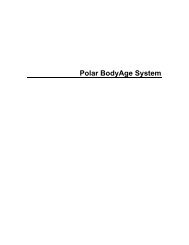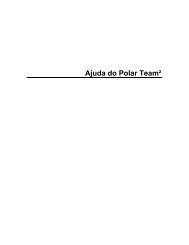Polar s3 Stride Sensor W.I.N.D. User Manual
Polar s3 Stride Sensor W.I.N.D. User Manual
Polar s3 Stride Sensor W.I.N.D. User Manual
You also want an ePaper? Increase the reach of your titles
YUMPU automatically turns print PDFs into web optimized ePapers that Google loves.
Meanwhile, Queensland about the same time was responding to the WiltshireReport, in which a provisional values charter for state schools was proposed andeducational authorities in several other states were trialing values frameworks fortheir systems.The Commonwealth Government too was ‘beginning to emerge from its neutraliststance when the so-called Civics Expert Group was set up’ with its 1994 reportconfirming ‘the priority of values education in the public sector’; though a change ofgovernment ‘somewhat delayed further developments at the Federal level’ for sometime. Then in mid-2002 the present Federal Government launched a ValuesEducation Study which was charged with the task of developing an agreedframework and encouraging better classroom practice, and this consultation is, ineffect, a progress report of this study. Its emphasis on action research is, Hill stated,‘to be applauded, and it’s also great to see boundaries being crossed: between states,and between the state and non-state sectors’.What are some pedagogic challenges?The current interest in experiments at the chalk-face is, Hill noted, ‘very timely’;albeit showing that values education is complex and controversial. He thencommented on a number of challenges coming to light in the reports of thoseexperiments.Describing the nature and sources of values‘I’m not sure’, he argued, ‘we yet know how to talk about values. The Final Report ofthe Values Education Study elected fairly summarily to adopt a definition byHalstead and Taylor which spoke of values as principles and standards that guidebehaviour. 1 This carries a cognitive weighting which potentially obscures themotivational aspect. How and why should propositions of thought be supposed tohave any real bearing on conduct? I sense that we’re still grappling with the problemof moving the student from “knowing the good to be desirable” to “desiring to do thegood.” 2 His own preferred definition in this context is that ‘values are “the prioritiesindividuals and societies attach to certain beliefs, experiences, and objects, in deciding howthey shall live and what they shall treasure”.’ This, he suggested, ‘shifts the focus from avalue being a merely cognitive state of mind to a whole-person decision, readiness or“disposition” to act in certain ways, given the opportunity’.Identifying the teaching domainsThis definition has significant implications for the way we view the teaching ofvalues. ‘First, it implies that there is a cognitive component, because value prioritiescan clearly be described in propositional terms, and are accessible to good reasonsbeing given for holding them. Commitment to a value isn’t merely a sociallyconditioned habit. But words like “experiences” and “treasure” invoke the affective1Values Education Study: Final Report (2003); 2.2c.f. Frankena, W. K. (1958). Towards a Philosophy of Moral Education, Harvard EducationalReview, 28, Fall 1958, 300-313.PAGE 5

















